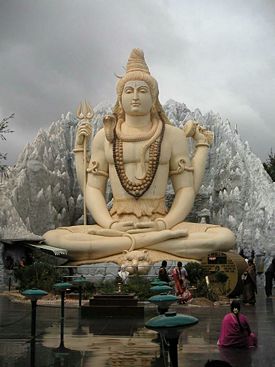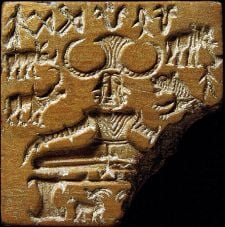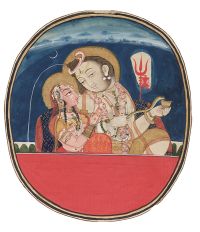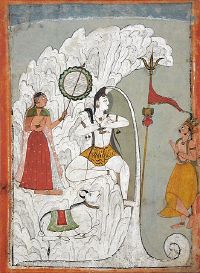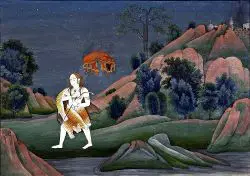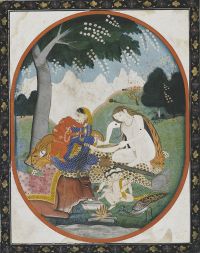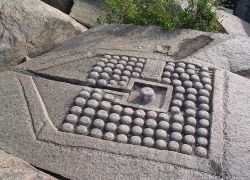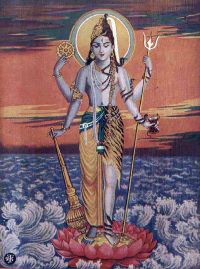Shiva
| ||||||||||||||||||
Shiva (from Sanskrit: शिव, meaning "Auspicious one") is a principal deity of Hinduism who is especially revered among the cluster of Hindu groups known as Shaivites. Widely worshiped by Hindu communities throughout India and the world, Shiva is an ancient Hindu deity that is associated with the paradoxical motifs of destruction and regeneration, eroticism and asceticism, sexuality and celibacy. Hindu religious iconography and mythology simultaneously describe him as a great ascetic as well as co-generator of the universe along with Shakti (the female principle of creation).
In images and sculpture, Shiva is often represented as immersed in deep meditation or dancing the Tandava upon the demon of ignorance in his manifestation of Nataraja, the lord of the dance. Shiva is usually worshiped as the Shiva linga, the phallic symbol (representing the male sexual organ) that symbolizes Shiva's creative regenerative power, potentiality, and, paradoxically, his ascetic restraint. Due to the symbol's sexual associations, however, it has often been seen as controversial and criticized by outsiders.
Shiva also plays a central role in the teachings of Tantra, whereby the interaction of Shiva and Shakti represent the renewal of the cosmos through the ongoing interplay of male-female sexual energy.
Etymology
The Sanskrit word Åiva or Shivam (Devanagari िशव) is an adjective meaning kind, friendly, gracious, or auspicious.[1] As a proper name it means "The Auspicious One," used as a euphemistic name for the vedic god Rudra.[2] In simple English transliteration, it is written either as Shiva or Siva. Pronunciation is written in the International Phonetic Alphabet as IPA: [ÉivÉ]. In the Rig Veda, Indra uses this word to describe himself several times. (2:20:3, 6:45:17, 8:93:3)
In the Tamil language, Siva literally means "the supreme one." The renowned Hindu philosopher Adi Sankara interprets Shiva to mean either "The Pure One," (i.e., the One who is not affected by three Gunas of Prakrti, Sattva, Rajas and Tamas) or "the One who purifies everyone by the very utterance of His name."[3] Swami Chinmayananda, in his translation of Vishnu Sahasranama further elaborates on that verse: Shiva means the One who is eternally pure, or the One who can never have any contamination of the imperfection of Rajas and Tamas [4]
The name Shiva may have derived from the Dravidian word âSivaâ meaning âto be red,â making it the equivalent of Rudra, âthe redâ Rig Veda.[5]
Historical Development
The Pashupati seal
A seal discovered during excavation of the Mohenjo-daro archaeological site in the Indus Valley has drawn attention as a possible representation of a "proto-Shiva" figure.[6] This "Pashupati" (Lord of Animals, or Lord of Beings Sanskrit paÅupati)[7] seal shows a seated figure, possibly ithyphallic, surrounded by animals. Sir John Marshall and others have claimed that this figure is a prototype of Shiva, and have described the figure as having three faces, seated in a "yoga posture" with the knees out and feet joined.
This claim has not fared well with some modern academics. Gavin Flood characterizes these views as "speculative," saying that while it is not clear from the seal that the figure has three faces, is seated in a yoga posture, or even that the shape is intended to represent a human figure, it is nevertheless possible that there are echoes of Shaiva iconographic themes, such as half-moon shapes resembling the horns of a bull.[8][9] Historian John Keay is more specifically dismissive, saying:
"â¦there is little evidence for the currency of this myth. Rudra, a Vedic deity later identified with Shiva, is indeed referred to as pasupati because of his association with cattle; but asceticism and meditation were not Rudra's specialties, nor is he usually credited with an empathy for animals other than kine. More plausibly, it has been suggested that the Harappan figure's heavily horned headgear bespeaks a bull sect, to which numerous other representations of bulls lend substance."[10]
Rudra
Shiva as we know him today shares many features with the Vedic god Rudra[11] and both Shiva and Rudra are viewed as the same personality in a number of Hindu traditions. Rudra, the god of the roaring storm, is usually portrayed in accordance with the element he represents as a fierce, destructive deity.
The oldest surviving text of Hinduism is the Rig Veda, which is dated to between 1700â1100 B.C.E. based on linguistic and philological evidence. A god named Rudra is mentioned in the Rig Veda. The name Rudra is still used as a name for Shiva. In RV 2.33 he is described as the "Father of the Maruts," a group of storm gods. Furthermore, the Rudram, one of the most sacred hymns of Hinduism found both in the Rig and the Yajur Vedas, and addressed to Rudra, invokes him as Shiva in several instances.
The identification of Shiva with the older god Rudra is not universally accepted, as Axel Michaels explains:
"To what extent Åiva's origins are in fact to be sought in Rudra is extremely unclear. The tendency to consider Åiva an ancient god is based on this identification, even though the facts that justify such a far-reaching assumption are meager."[12]
Rudra is called "The Archer" (Sanskrit: Åarva)[13] and the arrow is an essential attribute of Rudra.[14] This name appears in the Shiva Sahasranama, (list of a thousand names) and R. K. Sharma notes that it is used as a name of Shiva often in later languages.[15] The word is derived from the Sanskrit root Åarv- which means "to injure" or "to kill"[16] and Sharma uses that general sense in his interpretive translation of the name Åarva as "One who can kill the forces of darkness". The names Dhanvin ("Bowman") and BÄá¹ahasta ("Archer," literally "Armed with arrows in his hands")[17]
Identification with Vedic deities
Shiva's rise to a major position in the pantheon was facilitated by his identification with a host of Vedic deities, including Agni, Indra, PrajÄpati, VÄyu, and others.
Agni
Rudra and Agni have a close relationship.[18][19] The identification between Agni and Rudra in the Vedic literature was an important factor in the process of Rudra's gradual development into the later character as Rudra-Shiva.[20] The identification of Agni with Rudra is explicitly noted in the Nirukta, an important early text on etymology, which says "Agni is called Rudra also". The interconnections between the two deities are complex, and according to Stella Kramrisch:
- "The fire myth of Rudra-Åiva plays on the whole gamut of fire, valuing all its potentialities and phases, from conflagration to illumination."[21]
In the ÅatarudrÄ«a, some epithets of Rudra such as Sasipañjara ("Of golden red hue as of flame") and Tivaṣīmati ("Flaming bright") suggest a fusing of the two deities.[22] Agni is said to be a bull[23] and Lord Shiva possesses a bull as his vehicle, Nandi. The horns of Agni, who is sometimes characterized as a bull, are mentioned.[24][25] In medieval sculpture both Agni and the form of Shiva known as Bhairava have flaming hair as a special feature.[26]
Indra
There are several similarities between the Vedic god Indra and Shiva; both deities are known for having a thirst for an herb with narcotic properties called Soma. Moreover, each is associated with mountains, rivers, male fertility, fierceness, fearlessness, warfare, transgression of established mores, the Aum sound, the Supreme Self. In the ]]Rig Veda\\ the term Åiva is used to refer to Indra. (2.20.3,[27] 6.45.17,[28][29] and 8.93.3.[30])
Indra, like Shiva, is likened to a bull.[31][32]
Indra is likened to a white elephant named 'Airavat' instead of the bull.
However, in the Rig Veda, Rudra is the father of the Maruts, but he is never associated with their warlike exploits as is Indra.[33]
As a result of these multifarious precursors, modern historians believe that the figure of Shiva as we know him today was built-up over time, with the ideas of many regional sects being amalgamated into a single figure.[34]
Attributes of Shiva
- Third Eye: Shiva is often depicted with a third eye with which he burned Desire (KÄma) to ashes.[35] There has been controversy regarding the original meaning of Shiva's name Tryambakam (Sanskrit: तà¥à¤°à¥à¤¯à¤®à¥à¤¬à¤à¤®à¥), which occurs in many scriptural sources.[36] In classical Sanskrit the word ambaka denotes "an eye," and in the Mahabharata Shiva is depicted as three-eyed, so this name is sometimes translated as "Having Three Eyes".[37] However, in Vedic Sanskrit the word ambÄ or ambikÄ means "mother," and this early meaning of the word is the basis for the translation "Having Three Mothers" that was used by Max Müller and Arthur Macdonell.[38] Since no story is known in which Shiva had three mothers, E. Washburn Hopkins suggested that the name refers not to three mothers, but to three Mother-goddesses who are collectively called the AmbikÄs.[39] Other related translations have been "having three wives or sisters," or based on the idea that the name actually refers to the oblations given to Rudra, which according to some traditions were shared with the goddess AmbikÄ.[40]
- Blue Throat: The epithet NÄ«lakaá¹tha (Sanskrit नà¥à¤²à¤à¤£à¥à¤ ; nÄ«la = blue, kaá¹tha = throat)[41] refers to a story in which Shiva drank the poison churned up from the world ocean.[42]
- Crescent Moon: Shiva bears on his head the crescent of the moon.[43] The epithet ChandraÅekhara (Sanskrit: à¤à¤¨à¥à¤¦à¥à¤°à¤¶à¥à¤à¤° "Having the moon as his crest" - chandra = Moon, Åekhara = crest, crown)[44] refers to this feature. The placement of the moon on his head as a standard iconographic feature dates to the period when Rudra rose to prominence and became the major deity Rudra-Shiva.[45] The origin of this linkage may be due to the identification of the moon with Soma, and there is a hymn in the Rig Veda where Soma and Rudra are jointly emplored, and in later literature Soma and Rudra came to be identified with one another, as were Soma and the Moon.[46]
- Matted Hair: Shiva's distinctive hair style is noted in the epithets Jaá¹in, "The One with matted hair"[47] and Kapardin, "Endowed with matted hair"[48] or "wearing his hair wound in a braid in a shell-like (kaparda) fashion".
- Sacred Ganga: The Ganga river flows from the matted hair of Shiva. The epithet Gaá¹ gÄdhara ("Bearer of the river Gaá¹ gÄ") refers to this feature. The Ganga (Ganges), one of the major rivers of the country, is said to have made her abode in Shiva's hair. The legend of Bhagiratha states that when the sage of that name invoked the gods to send the divine Ganges to earth to relieve a drought and purify the remains of his ancestors, he was warned that the earth had not the capacity to withstand the descent of the Ganges from heaven, in pursuit of which he propitiated Siva to receive the Ganges upon her descent from heaven and release her with diminished force. Siva agreed to trap the youthful and mischievous Ganges in his matted locks and release her to the earth. It was thus, according to Hindu legend, that the Ganges came to be trapped in Siva's locks, and to be portrayed as flowing therefrom, in all representations of Siva.
- Ashes: Shiva smears his body with ashes (bhasma). Some forms of Shiva, such as Bhairava, are associated with a very old Indian tradition of cremation-ground asceticism that was practiced by some groups who were outside the fold of brahmanic orthodoxy.[49] These practices associated with cremation grounds are also mentioned in the Pali canon of Theravada Buddhism.[50] One epithet for Shiva is "Inhabitant of the cremation ground" (Sanskrit: ÅmaÅÄnavÄsin, also spelled Shmashanavasin) referring to this connection.[51]
- Tiger skin: He is often shown seated upon a tiger skin, an honor reserved for the most accomplished of Hindu ascetics, the Brahmarishis.
- Serpents: Shiva is often shown garlanded with a snake.
- Trident: (Sanskrit: Trishula) Shiva's particular weapon is the trident.
- Drum: A small drum shaped like an hourglass is known as a damaru (Sanskrit: á¸amaru). This is one of the attributes of Shiva in his famous dancing representation[52] known as Nataraja. A specific hand gesture (mudra) called á¸amaru-hasta (Sanskrit for "á¸amaru-hand") is used to hold the drum. This drum is particularly used as an emblem by members of the KÄpÄlika sect.
- Nandi, also known as Nandin, is the name of the bull that serves as Shiva's mount (Sanskrit: vÄhana).[53][54] Shiva's association with cattle is reflected in his name PaÅupati or Pashupati (Sanskrit पशà¥à¤ªà¤¤à¤¿), translated by Sharma as "Lord of cattle"[55] and by Kramrisch as "Lord of Animals," who notes that it is particularly used as an epithet of Rudra.[56]
- GanaGaá¹a : In Hinduism, the Gaá¹as (Devanagari: à¤à¤£) are attendants of Shiva and live in Kailasa. They are often referred to as the Boothaganas, or ghostly hosts, on account of their nature. Generally benign, except when their Lord is transgressed against, they are often invoked to intercede with the Lord on behalf of the devotee. Ganesha was chosen as their leader by Shiva, hence Ganesha's title gaá¹a-Ä«Åa or gaá¹a-pati, "lord of the gaá¹as".[57]
- Mount KailÄsa in the Himalayas is his traditional abode.[58] In Hindu mythology, Mount KailÄsa is conceived as resembling a Linga, the penis representing the center of the universe.[59]
- Varanasi (formerly Benares) is considered as the city specially-loved by Shiva, and is one of the holiest places of pilgrimage in India. It is referred to, in religious contexts, as Kashi.[60]
Mythology
According to Gavin Flood, "Åiva is a god of ambiguity and paradox," whose attributes include opposing themes.[61] The ambivalent nature of this deity is apparent in some of his names and the stories told about him.
Destroyer versus benefactor
In the Yajurveda two contrary sets of attributes for both malignant or terrific (Sanskrit: rudra) and benign or auspicious (Sanskrit: Åiva) forms can be found, leading Chakravarti to conclude that "all the basic elements which created the complex Rudra-Åiva sect of later ages are to be found here."[62] In the Mahabharata, Shiva is depicted as "the standard of invincibility, might, and terror," as well as a figure of honor, delight, and brilliance.[63] The duality of Shiva's fearful and auspicious attributes appears in contrasted names.
The name Rudra (Sanskrit रà¥à¤¦à¥à¤°) reflects his fearsome aspects. According to traditional etymologies, the Sanskrit name Rudra is derived from the root rud- which means "to cry, howl."[64] Stella Kramrisch notes a different etymology connected with the adjectival form raudra, which means wild, of rudra nature, and translates the name Rudra as "the Wild One" or "the Fierce God."[65] R.K. Sharma follows this alternate etymology and translates the name as "Terrible".[66] Hara (Sanskrit हर) is an important name that occurs three times in the Anushasanaparvan version of the Shiva Sahasranama, where it is translated in different ways each time it occurs, following a commentorial tradition of not repeating an interpretation. Sharma translates the three as "One who captivates," "One who consolidates," and "One who destroys."[67] Kramrisch translates it as "The Ravisher".[68] Another of Shiva's fearsome forms is as KÄla (Sanskrit: à¤à¤¾à¤²), "Time," and as MahÄkÄla (Sanskrit: महाà¤à¤¾à¤²), "Great Time," which ultimately destroys all things.[69][70][71] Bhairava (Sanskrit: à¤à¥à¤°à¤µ), "Terrible" or "Frightful"[72] is a fierce form associated with annihilation.[73]
In contrast, the name Åaá¹kara (Sanskrit शà¤à¥à¤à¤°), "Beneficent"[74] or "Conferring Happiness"[75] reflects his benign form. This name was adopted by the great Vedanta philosopher Åaá¹kara (c. 788-820 C.E.), who is also known as Shankaracharya.[76][77] The name Åambhu (Sanskrit: शमà¥à¤à¥), "Causing Happiness," also reflects this benign aspect.[78][79]
Ascetic versus householder
He is depicted as both an ascetic yogin and as a householder, roles which are mutually exclusive in Hindu society.[80] When depicted as a yogin he may be shown sitting and meditating.[81] His epithet MahÄyogin (The Great Yogi: MahÄ = great, Yogin = one who practices Yoga) refers to his association with yoga.[82] While Vedic religion was conceived mainly in terms of sacrifice, it was during the Epic period that concepts of tapas, yoga, and asceticism, became more important, and the depiction of Shiva as an ascetic sitting in philosophical isolation reflects these later concepts.[83]
As a family man and householder he has a wife, Parvati (also known as UmÄ), and two sons, Ganesha and Skanda. His epithet UmÄpati ("The husband of UmÄ") refers to this idea, and Sharma notes that two other variants of this name that mean the same thing, UmÄkÄnta and UmÄdhava, also appear in the sahasranama.[84] UmÄ in epic literature is known by many names, including PÄrvatÄ«.[85][86] She is identified with Devi, the Divine Mother, and with Shakti (divine energy).
Shiva and Parvati are the parents of Karthikeya and Ganesha. Karthikeya is worshipped in southern India (especially in Tamil Nadu and Karnataka) by the names Subrahmanyan, Shanmughan, Swaminathan and Murugan, and in northern India, is better known by the names Skanda, Kumara, or Karttikeya.[87]
Manifestations
Nataraja
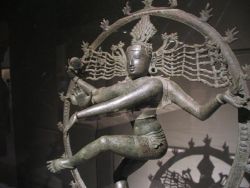
The depiction of Shiva as Nataraja (Tamil: நà®à®°à®¾à®à®¾, Sanskrit: naá¹arÄja, "Lord of Dance") is popular.[88][89] The names Nartaka ("Dancer") and Nityanarta ("Eternal Dancer") appear in the Shiva Sahasranama.[90] His association with dance and also with music is prominent in the Puranic period.[91] In addition to the specific iconographic form known as Nataraja, various other types of dancing forms (Sanskrit: ná¹tyamÅ«rti) are found in all parts of India, with many well-defined varieties in Tamil Nadu (in southern India) in particular.[92]
Daká¹£iá¹ÄmÅ«rti
Daká¹£iá¹ÄmÅ«rti (Sanskrit: दà¤à¥à¤·à¤¿à¤£à¤¾à¤®à¥à¤°à¥à¤¤à¤¿)[93] literally describes a form (mÅ«rti) of Shiva facing south (daká¹£iá¹a). This form represents Shiva in his aspect as a teacher of yoga, music, and wisdom, and giving exposition on the shastras.[94] This iconographic form for depicting Shiva in Indian art is mostly from Tamil Nadu.[95] Elements of this motif can include Shiva seated upon a deer-throne and surrounded by sages who are receiving his instruction.[96]
Mruthyunjaya
Literally translated as 'victor over death', this is an aspect of Shiva worshipped as the conqueror of Death as manifested in the Hindu lord of death, Yama. The particular legend in question deals with the sage Markandeya, who was fated to die at the age of 16. On account of the sage's worship and devotion to Shiva, the Lord vanquished Yama to liberate his devotee from death. Shiva is often worshipped as Mruthyunjaya by the aged or ill, to ward off death and mitigate its harshness when it does occur. He is worshipped as such at the temples of Thirupainyeeli, near Trichinopoly, and at a shrine in Thirukadaiyur, near Chidambaram.
Ardhanarishvara
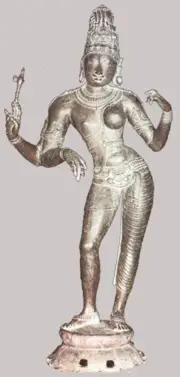
An iconographic representation of Shiva called Ardhanarishvara shows him with one half of the body as male, and the other half as female.[97] According to Ellen Goldberg, the traditional Sanskrit name for this form, (ArdhanÄrÄ«Åvara) is best translated as "the lord who is half woman," and not as "half-man, half-woman".[98]
TripurÄntaka
Shiva is often depicted as an archer in the act of destroying the triple fortresses, Tripura, of the Asuras.[99] Shiva's name TripurÄntaka (Sanskrit: तà¥à¤°à¤¿à¤ªà¥à¤°à¤¾à¤¨à¥à¤¤à¤), "Ender of Tripura," refers to this important story.[100]
Lingam
Apart from anthropomorphic images of Shiva, the worship of Shiva in the form of a lingam is also important.[101][102] These are depicted in various forms. One common form is the shape of a vertical rounded column.
In Shaivism, Shiva is the God of all and is worshipped by all, from Devas (gods) such as Brahma, Indra, by Asuras (demons) like Bana, Ravana, by humans like Adi Shankara, Nayanars, by creatures as diverse as Jatayu, an eagle, and Vali, an ape. Furthermore, people of different backgrounds and qualities worship Shiva with many temples having histories of even cranes, bees, elephants, spiders, snakes, worshipping Shiva and getting blessed. It concludes that the Good Lord blesses anyone who worships him with sincere devotion as there is no discrimination based on the seeker. Although Lord Shiva loves His devotees equally and does not ignore the meditation even of demons such as the rakshasas and asuras, He always finds ways to protect righteousness and never allows any evil to triumph over good.
In South India, five temples of Shiva are held to be particularly important, as being manifestations of him in the five elemental substances:
- Tiruvannamalai, as fire
- Chidambaram, as ether
- Srikalahasti, as air
- Tiruvanaikal, as water
- Conjeeveram, as earth
Names of Shiva

In Hinduism, deities are called by many names, which describe them in different ways. These names often refer to specific stories about the deities, functions they perform, or ways of thinking about them. Study of these names is helpful to understanding deities from multiple points of view. Some names are used by more than one deity, so looking for names that uniquely describe a deity is one way to pinpoint their functions.
His role as the primary deity of Shaivism is reflected in his epithets MahÄdeva ("great god"; mahÄ = great + deva = god), MaheÅvara ("great lord"; mahÄ = great + Ä«Åvara = lord), and ParameÅvara ("Supreme Lord").
There are at least eight different versions of the Shiva Sahasranama, devotional hymns (stotras) listing many names of Shiva.[103] Shiva also has DashaSahasranamas (10,000 names) that are found in the Mahanyasa. The Shri Rudram Chamakam, also known as the Åatarudriya, is a devotional hymn to Shiva hailing him by many names.[104]
Shiva, like some other Hindu deities, is said to have several incarnations, known as Avatars. Adi Shankara, the eighth-century philosopher of non-dualist Vedanta was named "Shankara" after Lord Shiva and is considered to have been an incarnation of Shiva.[105] In the Hanuman Chalisa Hanuman is identified as the eleventh avatar of Shiva.[106]
Relationship to Vishnu
During the Vedic period, both Vishnu and Shiva (as identified with Rudra) played relatively minor roles, but by the time of the Brahmanas (c. 1000-700 B.C.E.) both were gaining ascendance.[107] By the Puranic period both deities had major sects that competed with one another for devotees.[108] Many stories developed showing different types of relationships between these two important deities.
Sectarian forces each presented their own preferred deity as supreme. Vishnu in his myths "becomes" Shiva.[109] The Vishnu Purana (fourth c. C.E.) shows Vishnu awakening and becoming both BrahmÄ to create the world, and Shiva to destroy it.[110] Shiva also is viewed as a manifestation of Vishnu in the Bhagavata Purana.[111] In Shaivite myths, on the other hand, Shiva comes to the fore and acts independently and alone to create, preserve, and destroy the world.[112] In one Shaivite myth of the origin of the lingam, both Vishnu and BrahmÄ are revealed as emanations from Shiva's manifestation as a towering pillar of flame.[113] The ÅatarudrÄ«ya, a Shaivite hymn, says that Shiva is "of the form of Vishnu". Difference in viewpoints between the two sects is apparent in the story of Åarabha (also spelled "Sharabha"), the name of Shiva's incarnation in the composite form of man, bird, and beast. Shiva assumed that unusual form to chastise Vishnu in his hybrid form as Narasimha, the man-lion, who killed Hiranyakashipu, an ardent devotee of Shiva.[114][115]
Syncretic forces produced stories in which the two deities were shown in cooperative relationships and combined forms. Harihara is the name of a combined deity form of both Vishnu (Hari) and Shiva (Hara).[116] This dual form, which is also called Harirudra, is mentioned in the Mahabharata.[117] An example of a collaboration story is one given to explain Shiva's epithet MahÄbaleÅvara, "Lord of Great Strength" (Maha = great, Bala = strength, ĪÅvara = Lord). This name refers to story in which RÄvaá¹a was given a linga as a boon by Shiva on the condition that he carry it always. During his travels, he stopped near the present Deoghar in Bihar to purify himself and asked Narada a devotee of Vishnu in the guise of a Brahmin to hold the linga for him, but after some time Narada put it down on the ground and vanished. When Ravana returned, he could not move the linga, and it is said to remain there ever since.[118]
Notes
- â Vaman Shivram Apte, The Practical Sanskrit Dictionary (Delhi: Motilal Banarsidass Publishers, 1965, ISBN 8120805674), 919.
- â Arthur Anthony Macdonell, A Practical Sanskrit Dictionary (New Delhi: Munshiram Manoharlal Publishers, 1996, ISBN 81-21507154), 314.
- â Sri Vishnu Sahasranama, Ramakrishna Math edition, 47 and 122.
- â Swami Chinmayananda's translation of Vishnu sahasranama, 24, (Central Chinmaya Mission Trust).
- â Shyam Singh Shashi, Encyclopedia of Indian Tribes (New Delhi: Anmol Publications PVT. LTD., 1994, ISBN 8170418364), 190.
- â Gavin Flood, An Introduction to Hinduism (Cambridge University Press, 1996, ISBN 0521438780), 28-29.
- â For translation of paÅupati as "Lord of Animals" see: Axel Michaels, Hinduism: Past and Present. (Princeton, NJ: Princeton University Press, 2004, ISBN 0691089531), 312.
- â Flood 1996, 28-29.
- â Gavin Flood (ed.), The Blackwell Companion to Hinduism (Malden, MA: Blackwell Publishing Ltd., 2003, ISBN 1405132515), 204-205.
- â John Keay, India: A History (New York: Grove Press, 2000, ISBN 0802137970), 14.
- â Michaels, 216.
- â Michaels, 217.
- â For Åarva as a name of Shiva see: Apte, 910.
- â For archer and arrow associations see Stella Kramrisch, The Presence of Åiva (Princeton, NJ: Princeton University Press, 1981, ISBN 0691019304). Chapter 2, and 32.
- â Ram Karan Sharma, ÅivasahasranÄmÄá¹£á¹akam: Eight Collections of Hymns Containing One Thousand and Eight Names of Åiva (Delhi: Nag Publishers, 1996, ISBN 8170813506), 306.
- â For root Åarv- see: Apte, 910.
- â Swami Chidbhavananda, Siva Sahasranama Stotram (with Navavali) (Sri Ramakrishna Tapovanam, 1997), 33.
- â For general statement of the close relationship, and example shared epithets, see: Sivaramamurti, 11.
- â For an overview of the Rudra-Fire complex of ideas, see: Kramrisch, 15-19.
- â For quotation "An important factor in the process of Rudra's growth is his identification with Agni in the Vedic literature and this identification contributed much to the transformation of his character as Rudra-Åiva." see: Chakravarti, 17.
- â Kramrisch, 18.
- â For "Note Agni-Rudra concept fused" in epithets Sasipañjara and Tivaṣīmati see: Sivaramamurti, 45.
- â Rig-Veda, Book 6: HYMN XLVIII. Agni and Others Sacred Texts. Retrieved January 20, 2021.
- â For the parallel between the horns of Agni as bull, and Rudra, see: Chakravarti, 89.
- â RV 8.49; 10.155.
- â For flaming hair of Agni and Bhairava see: Sivaramamurti, 11.
- â For text of RV 2.20.3a as स नॠयà¥à¤µà¥à¤¨à¥à¤¦à¥à¤°à¥ à¤à¥à¤¹à¥à¤¤à¥à¤°à¤ सà¤à¤¾ िशवॠनरामसà¥à¤¤à¥ पाता । and translation as "May that young adorable Indra, ever be the friend, the benefactor, and protector of us, his worshiper" see: Ravi Prakash Arya, and K.L. Joshi, á¹gveda Saá¹hitÄ (Delhi: Parimal Publications, 2001, ISBN 8171101387), 48, volume 2.
- â For text of RV 6.45.17 as यॠà¤à¥à¤£à¤¤à¤¾à¤®à¤¿à¤¦à¤¾à¤¸à¤¿à¤¥à¤¾à¤ªà¤¿à¤°à¥à¤¤à¥ िशवठसà¤à¤¾ । स तà¥à¤µà¤ न à¤à¤¨à¥à¤¦à¥à¤° मà¥à¤²à¤¯ ॥ and translation as "Indra, who has ever been the friend of those who praise you, and the insurer of their happiness by your protection, grant us felicity" see: Arya & Joshi 2001, 91, volume 3.
- â For translation of RV 6.45.17 as "Thou who hast been the singers' Friend, a Friend auspicious with thine aid, As such, O Indra, favour us" see: T.H. Griffith, The Hymns of the á¹gveda (Delhi: Motilal Banarsidass, 1973, ISBN 812080046X), 310.
- â For text of RV 8.93.3 as स न à¤à¤¨à¥à¤¦à¥à¤°à¤ सिवठसà¤à¤¾à¤¶à¥à¤à¤¾à¤µà¤¦à¥ à¤à¥à¤®à¤¦à¥à¤¯à¤µà¤®à¤¤à¥ । à¤à¤°à¥à¤§à¤¾à¤°à¥à¤µ दà¥à¤¹à¤¤à¥ ॥ and translation as "May Indra, our auspicious friend, milk for us, like a richly-streaming (cow), wealth of horses, kine, and barley" see: Arya & Joshi 2001, 48, volume 2.
- â For the bull parallel between Indra and Rudra see: Chakravarti, 89.
- â RV 7.19.
- â For the lack of warlike connections and difference between Indra and Rudra, see: Chakravarti, 8.
- â Keay, xxvii.
- â For Shiva as depicted with a third eye, and mention of the story of the destruction of Kama with it, see: Flood 1996, 151.
- â For a review of theories about the meaning of tryambaka, see: Chakravarti, 37-39.
- â For usage of the word ambaka in classical Sanskrit and connection to the Mahabharata depiction, see: Chakravarti, 38-39.
- â For vedic Sanskrit meaning and "having three mothers" as the translation of Max Müller and Macdonell, see: Chakravarti, 37-38.
- â For discussion of the problems in translation of this name, and the hypothesis regarding the AmbikÄs see: E. Washburn Hopkins, Epic Mythology (New York: Biblo and Tannen, 1969), 220.
- â For the AmbikÄ variant, see: Chakravarti, 17, 37.
- â Sharma 1996, 290
- â Flood 1996, 78.
- â For the moon on the forehead see: Chakravarti, 109.
- â For Åekhara as crest or crown, see: Apte, 926.
- â For the moon iconography as marking the rise of Rudra-Shiva, see: Chakravarti, 58.
- â For discussion of the linkages between Soma, Moon, and Rudra, and citation to RV 7.74, see: Chakravarti, 57-58.
- â Chidbhavananda, 22.
- â Sharma 1996, 279.
- â Flood 1996, 92, 161.
- â Flood 1996, 161.
- â Chidbhavananda, 23.
- â Eva Rudy Jansen, The Book of Hindu Imagery (Havelte, Holland: Binkey Kok Publications BV, 1993, ISBN 9074597076), 44.
- â For a review of issues related to the evolution of the bull (Nandin) as Shiva's mount, see: Chakravarti, 99-105.
- â For spelling of alternate proper names NandÄ« and Nandin see: Margaret Stutley, The Illustrated Dictionary of Hindu Iconography Munshiram Manoharlal, 2003, ISBN 8121510872), 98.
- â Sharma 1996, 291
- â Kramrisch, 479.
- â Anna L. Dallapiccola, Dictionary of Hindu Lore and Legend (Thames & Hudson, 2004, ISBN 0500510881).
- â Flood 1996, 151.
- â For identification of Mount KailÄsa as the central linga, see: Stutley 1985, 62.
- â Keay, 33.
- â Flood 1996, 150.
- â For quotation regarding Yajur Veda as containing contrary sets of attributes, and marking point for emergence of all basic elements of later sect forms, see: Chakravarti, 7.
- â Sharma 1988, 20-21.
- â For rud- meaning "cry, howl" as a traditional etymology see: Kramrisch, 5.
- â M. Mayrhofer, Concise Etymological Sanskrit Dictionary s.v. "rudra," is provided in: Kramrisch, 5.
- â Sharma 1996, 301.
- â Sharma 1996, 314.
- â Kramrisch, 473.
- â For translation of MahÄkÄla as "Time beyond time" see: Kramrisch, 476.
- â For the name KÄla translated as "time; death," see: Kramrisch, 474.
- â The name KÄla appears in the Shiva Sahasranama, where it is translated by Ram Karan Sharma as "(The Supreme Lord of) Time." See: Sharma 1996, 280.
- â For à¤à¥à¤°à¤µ as one of the eight forms of Shiva, and translation of the adjectival form as "terrible" or "frightful" see: Apte, 727, left column.
- â For Bhairava form as associated with terror see: Kramrisch, 471.
- â Sharma 1996, 306
- â Kramrisch, 481.
- â For adoption of the name Åaá¹kara by Shankaracarya see: Kramrisch, 481.
- â For dating Shankaracharya as 788-820 C.E. see: Flood 1996, 92.
- â For translation of Åambhu as "Causing Happiness" see: Kramrisch, 481.
- â For speculation on the possible etymology of this name, see: Chakravarti, 28 (note 7), and 177.
- â Flood 1996, 150-151.
- â For Shiva's representation as a yogin, see: Chakravarti, 32.
- â For name MahÄyogi and associations with yoga, see, Chakravarti, 23, 32, 150.
- â For the ascetic yogin form as reflecting Epic period influences, see: Chakravarti, 32.
- â For UmÄpati, UmÄkÄnta, and UmÄdhava as names in the Shiva Sahasranama literature, see: Sharma 1996, 278.
- â For UmÄ as the oldest name, and variants including PÄrvatÄ«, see: Chakravarti, 40.
- â For PÄrvatÄ« identified as the wife of Shiva, see: Kramrisch, 479.
- â For regional name variants of Karttikeya see: Shakti M. Gupta, Karttikeya: The Son of Shiva (Bombay: Somaiya Publications Pvt. Ltd., 1988, ISBN 8170391865), Preface.
- â For description of the nataraja form see: Jansen, 110-111.
- â For interpretation of the naá¹arÄja form see: Heinrich Zimmer, Myths and Symbols in Indian Art and Civilization (Princeton, NJ: Princeton University Press, 1946, ISBN 0691017786), 151-157.
- â For names Nartaka (Sanskrit नरà¥à¤¤à¤) and Nityanarta (Sanskrit नितà¥à¤¯à¤¨à¤°à¥à¤¤) as names of Shiva, see: Sharma 1996, 289.
- â For prominence of these associations in puranic times, see: Chakravarti, 62.
- â For popularity of the ná¹tyamÅ«rti and prevalence in South India, see: Chakravarti, 63.
- â For iconographic description of the Daká¹£iá¹ÄmÅ«rti form, see: Sivaramamurti 1976, 47.
- â For description of the form as representing teaching functions, see: Kramrisch, 472.
- â For characterization of Daká¹£iá¹ÄmÅ«rti as a mostly south Indian form, see: Chakravarti, 62.
- â For the deer-throne and the audience of sages as Daká¹£iá¹ÄmÅ«rti, see: Chakravarti, 155.
- â Ellen Goldberg, The Lord Who is Half Woman: ArdhanÄrÄ«Åvara in Indian and Feminist Perspective (Albany, NY: State University of New York Press, 2002, ISBN 079145326X), 1.
- â Goldberg specifically rejects the translation by Frederique Marglin (1989) as "half-man, half-woman," and instead adopts the translation by Marglin as "the lord who is half woman" as given in Marglin 1989, 216; Goldberg, 1.
- â For evolution of this story from early sources to the epic period, when it was used to enhance Shiva's increasing influence, see: Chakravarti, 46.
- â For the TripurÄntaka form, see: Sivaramamurti 1976, 34
- â Michaels, 216.
- â Flood 1996, 29.
- â Sharma 1996, viii-ix.
- â Kramrisch, 71-74.
- â Padma Purana 6.236.7-11
- â Goswami Tulsidas, Hanuman Chalisa (Chennai, India: Sri Ramakrishna Math, 1985, ISBN 8171200869), 5.
- â For relatively minor position in Vedic times, and rise in progress by 1000-700 B.C.E. see: Zimmer, 1946, 125, note 2.
- â For the rise in popularity of Shiva and Vishnu, and the role of Puranas in promoting sectarian positions, see: Flood 1996, 110-111.
- â For Visnu becoming Shiva in Vaishnava myths, see: Zimmer 1946, 125.
- â For Vishnu Purana dating of fourth c. C.E. and role of Vishnu as supreme deity, see: Flood 1996, 111.
- â For identification of Shiva as a manifestation of Vishnu see: Bhagavata Purana 4.30.23, 5.17.22-23, 10.14.19.
- â For predominant role of Shiva in some myths, see: Zimmer 1946, 128.
- â For the lingodbhava myth, and Vishnu and BrahmÄ as emanations of Shiva, see: Zimmer 1946, 128-129.
- â For Åarabha as an "animal symplegma" form of Shiva, see: Kramrisch, 481.
- â For incarnation in composite form as man, bird, and beast to chastise Narasimha, see: Chakravarti, 49.
- â Chakravarti, 54-55.
- â For Harirudra citation to Mbh. III.39.76f see: Hopkins, 221.
- â For the story of RÄvaá¹a and the MahÄbaleÅvara linga see: Chakravarti, 168.
ReferencesISBN links support NWE through referral fees
- Apte, Vaman Shivram. The Practical Sanskrit Dictionary, Fourth rev. and enlarged ed., Delhi: Motilal Banarsidass Publishers, 1965. ISBN 8120805674.
- Arya, Ravi Prakash, and K.L. Joshi. á¹gveda Saá¹hitÄ: Sanskrit Text, English Translation. Delhi: Parimal Publications, 2001. ISBN 8171101387 (Set of four volumes).
- Chakravarti, Mahadev. The Concept of Rudra-Åiva Through The Ages, Second Rev. ed. Delhi: Motilal Banarsidass, 1994. ISBN 8120800532.
- Chidbhavananda, Swami. Siva Sahasranama Stotram (with Navavali). Sri Ramakrishna Tapovanam, 1997.
- Courtright, Paul B. Gaá¹eÅa: Lord of Obstacles, Lord of Beginnings. New York: Oxford University Press, 1985. ISBN 0195057422.
- Dallapiccola, Anna L. Dictionary of Hindu Lore and Legend. Thames & Hudson, 2004. ISBN 0500284024.
- Flood, Gavin. An Introduction to Hinduism. Cambridge University Press, 1996. ISBN 0521438780.
- Flood, Gavin (ed.). The Blackwell Companion to Hinduism. Malden, MA: Blackwell Publishing Ltd., 2003. ISBN 1405132515.
- Goldberg, Ellen. The Lord Who is Half Woman: ArdhanÄrÄ«Åvara in Indian and Feminist Perspective. Albany, NY: State University of New York Press, 2002. ISBN 079145326X.
- Griffith, T.H. The Hymns of the á¹gveda, (New Rev. ed., Delhi: Motilal Banarsidass, 1973. ISBN 812080046X.
- Gupta, Shakti M. Karttikeya: The Son of Shiva. Bombay: Somaiya Publications Pvt. Ltd., 1988. ISBN 8170391865.
- Hopkins, E. Washburn. Epic Mythology. New York: Biblo and Tannen, 1969.
- Jansen, Eva Rudy. The Book of Hindu Imagery. Havelte, Holland: Binkey Kok Publications BV, 1993. ISBN 9074597076.
- Keay, John. India: A History. New York: Grove Press, 2000. ISBN 0802137970.
- Kramrisch, Stella. The Presence of Åiva. Princeton, NJ: Princeton University Press, 1981. ISBN 0691019304.
- Macdonell, Arthur Anthony. A Practical Sanskrit Dictionary. New Delhi: Munshiram Manoharlal Publishers, 1996. ISBN 8121507154.
- Michaels, Axel. Hinduism: Past and Present. Princeton, NJ: Princeton University Press, 2004. ISBN 0691089531.
- Sarup, Lakshman. The Nighaá¹á¹u and The Nirukta. Reprint: Delhi: Motilal Banarsidass, 2002. ISBN 8120813812.
- Sharma, Ram Karan. Elements of Poetry in the MahÄbhÄrata, Second ed., Delhi: Motilal Banarsidass, 1988. ISBN 8120805445.
- Sharma, Ram Karan. ÅivasahasranÄmÄá¹£á¹akam: Eight Collections of Hymns Containing One Thousand and Eight Names of Åiva. Delhi: Nag Publishers, 1996. ISBN 8170813506.
- Shashi, Shyam Singh. Encyclopedia of Indian Tribes. New Delhi: reprint Anmol Publications PVT. LTD., 1994. ISBN 8170418364.
- Stutley, Margaret. The Illustrated Dictionary of Hindu Iconography. First Indian Edition: Munshiram Manoharlal, 2003. ISBN 8121510872.
- Tulsidas, Goswami. Hanuman Chalisa. Chennai, India: Sri Ramakrishna Math, 1985. ISBN 8171200869.
- Zimmer, Heinrich. Myths and Symbols in Indian Art and Civilization. Princeton, NJ: Princeton University Press, 1946. ISBN 0691017786.
Credits
New World Encyclopedia writers and editors rewrote and completed the Wikipedia article in accordance with New World Encyclopedia standards. This article abides by terms of the Creative Commons CC-by-sa 3.0 License (CC-by-sa), which may be used and disseminated with proper attribution. Credit is due under the terms of this license that can reference both the New World Encyclopedia contributors and the selfless volunteer contributors of the Wikimedia Foundation. To cite this article click here for a list of acceptable citing formats.The history of earlier contributions by wikipedians is accessible to researchers here:
The history of this article since it was imported to New World Encyclopedia:
Note: Some restrictions may apply to use of individual images which are separately licensed.
